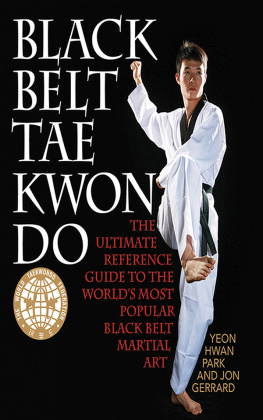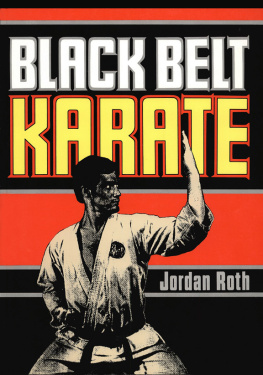BLACK BELT
TAE KWON DO
The Ultimate Reference Guide to the
Worlds Most Popular Black Belt Martial Art
BLACK BELT
TAE KWON DO
Yeon Hwan Park Jon Gerrard

Copyright 2000, 2013 by Yeon Hwan and Jon Gerrard All Rights Reserved. No part of this book may be reproduced in any manner without the express written consent of the publisher, except in the case of brief excerpts in critical reviews or articles. All inquiries should be addressed to Skyhorse Publishing, 307 West 36th Street, 11th Floor, New York, NY 10018. Skyhorse Publishing books may be purchased in bulk at special discounts for sales promotion, corporate gifts, fund-raising, or educational purposes. Special editions can also be created to specifications. For details, contact the Special Sales Department, Skyhorse Publishing, 307 West 36th Street, 11th Floor, New York, NY 10018 or info@skyhorsepublishing.com.
Skyhorse and Skyhorse Publishing are registered trademarks of Skyhorse Publishing, Inc., a Delaware corporation. Visit our website at www.skyhorsepublishing.com. 10 9 8 7 6 5 4 3 2 1 Library of Congress Cataloging-in-Publication Data is available on file. ISBN: 978-1-62087-574-2 Printed in India
C ONTENTS
P REFACE
In the years since we wrote our first book,
Tae Kwon Do: The Ultimate Reference Guide to the Worlds Most Popular Martial Art, many people have expressed their pleasure with the book as a reference guide and teaching aid. The one thing that each of them has commented on, however, is the lack of information on black belt techniques. When we wrote that first book, it was our intention to encompass only the color belt/student level techniques to provide beginning Tae Kwon Do students with a means to allow them to study and practice more effectively on their own.
To our delight, the book has achieved that and more. Across the United States, and in other countries as well, many Tae Kwon Do masters use the book as a primer for their students. At all Y. H. Park Taekwondo Centers, students are encouraged to obtain a copy of the book to help them when practicing on their ownand the results are impressive. Students find ready answers by referring to the book, allowing them to work through forms or techniques on their own.
Time and again we have seen students accelerate mastering the various techniques by using that book. Now we have written this companion book for black belt-level practitioners. As with the first book we have included clear photographic representations of each technique and form to allow practitioners to work more effectively on their own. We want to emphasize, however, that no book can take the place of actual instruction. These books are intended to serve as study aids and sources of information. Pictures cannot replace the knowing eye of an experienced instructor.
Written explanations cannot convey the same understanding of timing and focus imparted by a qualified master. In other words, you cannot become an instant black belt by reading this, or any other, book. However, students of the art will find these books to be valuable references on every aspect of the art. Black belts are the leaders of the Tae Kwon Do community. Lower level practitioners look to them for guidance. It is expected that once a student reaches the level of black belt he or she will assist with the training of the lower belts.
Traditionally, the rank of black belt has been understood to mean advanced student, or one who has mastered all of the basic techniques. In fact, first to third degree black belts are addressed by the title chokyonim, which means instructor. Understanding this, we have also included in this book sections on how to effectively teach Tae Kwon Do. Although a person may be an impressive martial artist, it doesnt automatically mean that teaching will come naturally to him or her. We have drawn upon our years of teaching experience to put together what we feel is a solid core of instructional approaches. As with the art itself, however, teaching is not something learned without proper training.
Some students feel that merely achieving the level of black belt qualifies them to be teachers. A few even attempt to open their own schools. This is a mistake. Although they have earned the title of chokyonim, it is only under the watchful tutelage of a seasoned master that a person can learn to be an effective teacher. Even those gifted with natural teaching ability can benefit from apprenticing themselves to an experienced master. After all, it is your students who will suffer if you are not properly prepared to teach them.
Finally, we want to repeat the invitation we extended in our first book. To truly understand and appreciate Tae Kwon Do, one must experience it. Come, study and experience with us. Grandmaster Yeon Hwan Park Jon Gerrard  Grandmaster Park (center) and Mr. Gerrard (second from right) with the Y.H. Park instructor staff
Grandmaster Park (center) and Mr. Gerrard (second from right) with the Y.H. Park instructor staff
A CKNOWLEDGMENTS
We want to thank the following people for graciously donating their time and efforts to help us make this book possible: Master Ha Young Cho Master Young S.
Kim Master Brian C. Jang Master Keun H. Lee Instructor Seung M. Kim Earl Anderson We would also like to extend a special thanks to Peter Kohn, who took all of the photographs that appear in the book. Finally, we want to acknowledge the special assistance of Team-USA for their invaluable contribution to the sections on managing and marketing a Tae Kwon Do school.  I am pleased to give my enthusiastic endorsement to this book.
I am pleased to give my enthusiastic endorsement to this book.
I was immensely pleased when I learned that Master Park and Mr. Gerrard were working on a sister book to their original work, Tae Kwon Do. Their first book has become the definitive reference guide for Taekwondo practitioners around the world. And with good reason, Master Park and Mr. Gerrard have succeeded in concisely organizing the elements of our art into a single, easy-to-understand volume. Now they have done the same for black belt students.
This book is a worthy companion to their earlier work. Not only does it clearly illustrate the advanced level techniques, it also goes beyond a mere explanation of the physical techniques to include essential information on effective teaching and training practices. This will benefit both instructors and student alike. For anyone interested in running a school, the information they have put together on managing and marketing is invaluable. Anyone who considers himself a serious student of our art should make these books an essential part of his library.  Official Sport in Sydney 2000 Olympic Games
Official Sport in Sydney 2000 Olympic Games It is with great pleasure that I give my strong endorsement to this book on the art of Tae Kwon Do.
It is with great pleasure that I give my strong endorsement to this book on the art of Tae Kwon Do.
Like everyone else in the Tae Kwon Do community, I am very familiar with the first book written by Master Park and Mr. Gerrard. Its clear explanations of the basic techniques of our art have made it the instructional manual and reference guide of choice for a great many practitioners. Now they are bringing us this excellent book on Black Belt level techniques. This sequel has been long awaited by students and instructors alike. Continuing where the original book left off,
Next page












 Copyright 2000, 2013 by Yeon Hwan and Jon Gerrard All Rights Reserved. No part of this book may be reproduced in any manner without the express written consent of the publisher, except in the case of brief excerpts in critical reviews or articles. All inquiries should be addressed to Skyhorse Publishing, 307 West 36th Street, 11th Floor, New York, NY 10018. Skyhorse Publishing books may be purchased in bulk at special discounts for sales promotion, corporate gifts, fund-raising, or educational purposes. Special editions can also be created to specifications. For details, contact the Special Sales Department, Skyhorse Publishing, 307 West 36th Street, 11th Floor, New York, NY 10018 or info@skyhorsepublishing.com.
Copyright 2000, 2013 by Yeon Hwan and Jon Gerrard All Rights Reserved. No part of this book may be reproduced in any manner without the express written consent of the publisher, except in the case of brief excerpts in critical reviews or articles. All inquiries should be addressed to Skyhorse Publishing, 307 West 36th Street, 11th Floor, New York, NY 10018. Skyhorse Publishing books may be purchased in bulk at special discounts for sales promotion, corporate gifts, fund-raising, or educational purposes. Special editions can also be created to specifications. For details, contact the Special Sales Department, Skyhorse Publishing, 307 West 36th Street, 11th Floor, New York, NY 10018 or info@skyhorsepublishing.com.  Grandmaster Park (center) and Mr. Gerrard (second from right) with the Y.H. Park instructor staff
Grandmaster Park (center) and Mr. Gerrard (second from right) with the Y.H. Park instructor staff I am pleased to give my enthusiastic endorsement to this book.
I am pleased to give my enthusiastic endorsement to this book. Official Sport in Sydney 2000 Olympic Games
Official Sport in Sydney 2000 Olympic Games It is with great pleasure that I give my strong endorsement to this book on the art of Tae Kwon Do.
It is with great pleasure that I give my strong endorsement to this book on the art of Tae Kwon Do.